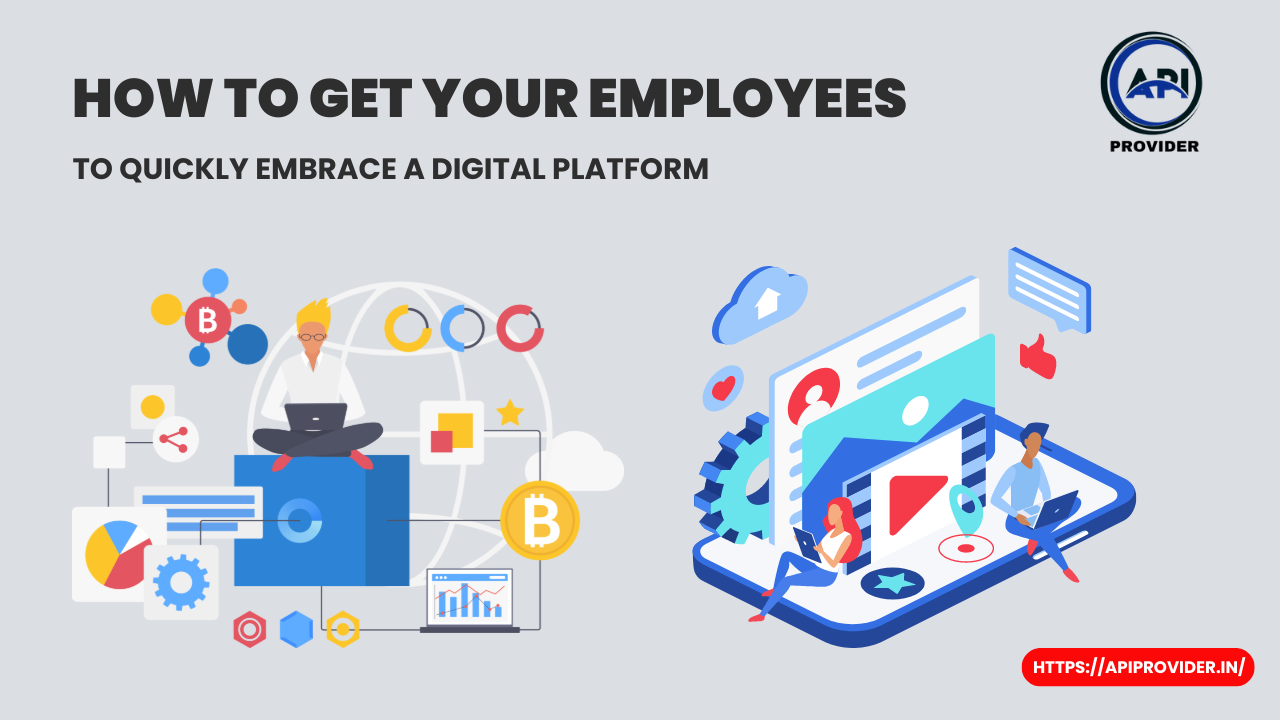How To Get Your Employees To Quickly Embrace A Digital Platform: In today’s fast-paced business world, digital platforms are essential for staying competitive and efficient. However, getting employees to embrace these new tools can be challenging. Why is this the case, and what can you do to change it smoother? Let’s dive into some practical strategies to help your team quickly adapt to a digital platform.

Understanding the Digital Platform
What is a Digital Platform?
A digital platform is a set of tools and services that facilitate business processes through technology. These platforms can range from project management software to communication tools and data analytics systems. They are designed to streamline operations, improve productivity, and enhance collaboration.
Read Also..
- API Provider Payment Gateway: Zero Transaction Fee
- Best Payment Gateway for Small Businesses in India: Focusing on the Best QR Code Service Provider
Benefits of Digital Platforms for Businesses
Digital platforms offer numerous benefits, including:
- Improved Efficiency: Automating routine tasks saves time and reduces errors.
- Better Communication: Tools like Slack or Microsoft Teams improve team collaboration.
- Data-Driven Decisions: Analytics platforms provide insights that inform strategic decisions.
- Cost Savings: Digital tools can reduce overhead costs and improve resource allocation.
Identifying Employee Resistance
Common Reasons for Resistance
Resistance to new digital platforms can stem from various factors:
- Fear of Change: Employees may worry about their ability to adapt.
- Lack of Understanding: Not knowing the benefits or how to use the platform.
- Comfort with Current Systems: Preferring familiar tools and processes.
How to Identify Resistance Early
Early signs of resistance include:
- Low Engagement: Employees not participating in training sessions.
- Negative Feedback: Complaints or concerns about the new platform.
- Performance Issues: Declines in productivity or errors.
Developing a Clear Vision and Strategy
Setting Clear Objectives
Clearly define what you want to achieve with the digital platform. Objectives could include improving communication, increasing productivity, or enhancing data accuracy.
Aligning the Digital Platform with Business Goals
Ensure that the platform supports your overall business goals. This alignment helps employees understand the importance of the new tool and how it contributes to the company’s success.
Choosing the Right Digital Platform
Evaluating Different Platforms
Research and compare various digital platforms. Consider factors like ease of use, features, integration capabilities, and cost.
Considering Employee Needs and Preferences
Involve employees in the selection process. Their input can help identify which platform best meets their needs and preferences, increasing the likelihood of adoption.
Communicating the Change
Effective Communication Strategies
Communicate the benefits and necessity of the digital platform clearly and frequently. Use multiple channels like emails, meetings, and intranet posts to reach all employees.
The Role of Leadership in Communication
Leaders should champion the change, showing commitment and enthusiasm. Their support can significantly influence employee attitudes toward the new platform.
Training and Support
Designing an Effective Training Program
Provide comprehensive training tailored to different learning styles. Include hands-on sessions, tutorials, and Q&A forums.
Providing Ongoing Support
Offer continuous support through help desks, online resources, and regular check-ins to address any issues or questions.
Involving Employees in the Process
Encouraging Employee Feedback
Create channels for employees to provide feedback on the platform. This feedback can identify issues and areas for improvement.
Creating a Sense of Ownership
Involve employees in decision-making and implementation processes. This involvement fosters a sense of ownership and responsibility for the platform’s success.
Creating a Positive Digital Culture
Fostering a Digital Mindset
Encourage a culture that values innovation and technology. Highlight the benefits of digital tools in everyday work.
Recognizing and Rewarding Digital Engagement
Acknowledge and reward employees who actively engage with the platform. Recognition can be in the form of awards, public acknowledgment, or incentives.
Using supports and Influencers
Identifying and Empowering Digital Champions
Select tech-savvy employees to act as digital champions. They can help train others and promote the platform’s benefits.
Leveraging Peer Influence
Encourage champions to share their positive experiences and tips with peers. Peer influence can be a powerful motivator for adoption.
Monitoring Progress and Providing Feedback
Setting Up Metrics for Success
Define key performance indicators (KPIs) to measure the platform’s impact. Metrics might include usage rates, productivity improvements, or error reductions.
Regularly Reviewing and Adjusting Strategies
Review progress regularly and adjust strategies as needed. Continuous improvement ensures the platform meets evolving business needs.
Addressing Challenges and Setbacks
Common Challenges in Digital Adoption
Challenges may include technical issues, resistance to change, or lack of training.
Strategies for Overcoming Setbacks
Address challenges promptly by providing additional training, resolving technical issues, and reinforcing the benefits of the platform.
Highlighting Success Stories
Sharing Examples of Successful Adoption
Share stories of teams or individuals who have successfully adopted the platform. Success stories can motivate others to embrace the change.
Celebrating Milestones and Achievements
Celebrate key milestones and achievements related to the platform’s adoption. Celebrations can boost morale and encourage continued engagement.
Ensuring Long-Term Adoption
Sustaining Engagement Over Time
Maintain engagement by regularly updating the platform and providing ongoing training.
Planning for Future Digital Initiatives
Plan for future digital initiatives to keep your business at the forefront of technological advancements.
Conclusion
Getting your employees to quickly embrace a digital platform requires a strategic approach that includes clear communication, comprehensive training, and ongoing support. By involving employees in the process and fostering a positive digital culture, you can overcome resistance and ensure successful adoption.
FAQs
How long does it typically take for employees to embrace a new digital platform?
The time frame can vary, but with effective communication and training, most employees can begin to adapt within a few weeks to a few months.
What are the most common obstacles to digital platform adoption?
Common obstacles include resistance to change, lack of understanding of the platform’s benefits, and inadequate training.
How can we measure the success of digital platform adoption?
Success can be measured through metrics like user engagement, productivity improvements, and error reductions.
What role do managers play in facilitating digital platform adoption?
Managers play a crucial role by communicating the benefits, supporting training efforts, and leading by example.
Are there specific digital platforms that are easier for employees to adopt?
Ease of adoption can depend on the platform’s user interface, training resources, and integration capabilities. Involving employees in the selection process can help identify the most suitable platform.
